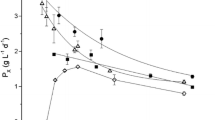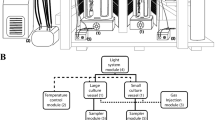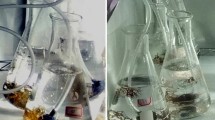Abstract
An integrated system of solar light, artificial light and organic carbon supply was developed for cyclic photoautotrophic-heterotrophic cultivation of photosynthetic cells. The energy source for the culture is automatically switched to solar light energy (when the weather is sunny), to artificial light energy (during the cloudy period of the day) or to organic carbon source (at night). Thus minimum amount of artificial light is used while ensuring continuous light supply to the culture during the photoautotrophic phase. The α-tocopherol productivity by Euglena gracilis in this system was more than 5 times higher than the value obtained in pure photoautotrophic culture under the same experimental conditions.
Similar content being viewed by others
References
Grobbelaar JU,Soeder CJ (1985) Respiration losses in green alga cultivated in raceway ponds. J. Plankton Res. 7: 497-506.
Ogbonna JC,Tanaka H (1996) Night biomass loss and changes in biochemical composition of cells during light/dark cyclic culture of Chlorella pyrenoidosa. J. Ferment. Bioeng. 82: 558-564.
Ogbonna JC,Tanaka H (1998) Cyclic autotrophic/heterotrophic cultivation of photosynthetic cells: A method of achieving continuous cell growth under light/dark cycles. Bioresour. Technol. 65: 65-72.
Ogbonna JC,Soejima T,Tanaka H (1999a) An integrated solar and artificial light system for internal illumination of photobioreactors. J. Biotechnol. 70: 289-297.
Ogbonna JC,Tomiyama S,Tanaka H (1999b) Production of β-tocopherol by sequential heterotrophic-photoautotrophic cultivation of Euglena gracilis. J. Biotechnol. 70: 213-221.
Ogbonna JC,Tomiyama S,Tanaka H (1998) Heterotrophic cultivation of Euglena gracilis Z for efficient production of β-tocopherol. J. Appl. Phycol. 10: 67-74.
Ogbonna JC,Yada H,Masui H,Tanaka H (1996) A novel internally illuminated stirred tank photobioreactor for large scale cultivation of photosynthetic cells. J. Ferment. Bioeng. 82: 61-67.
Shigeoka S,Onishi T,Nakano T (1986) The contents and subcellular distribution of tocopherols in Euglena gracilis. Agric. Biol. Chem. 50: 1063-1065.
Takeyama H,Kanamaru A,Yoshino Y,Kakuta H,Kawamura Y,Matsunaga T (1997) Production of antioxidant vitamins, β-carotene, vitamin C, and vitamin E by two-step culture of Euglena gracilis Z. Biotechnol. Bioeng. 53: 185-190.
Torzillo G,Sacchi A,Materassi R,Richmond, A (1991a) Effect of temperature on yield and night biomass loss in Spirulina platensis grown outdoors in tubular photobioreactors. J. Appl. Phycol. 3: 103-109.
Torzillo G,Sacchi A,Materassi R (1991b) Temperature as an important factor affecting productivity and night biomass loss in Spirulina platensis grown outdoors in tubular photobioreactors. Bioresour. Technol. 38: 98-100.
Vonshak A,Richmond A (1988) Mass production of the blue-green alga Spirulina: an overview. Biomass 15: 233-247.
Author information
Authors and Affiliations
Corresponding author
Rights and permissions
About this article
Cite this article
Ogbonna, J.C., Soejima, T., Ugwu, C.U. et al. An integrated system of solar light, artificial light and organic carbon supply for cyclic photoautotrophic-heterotrophic cultivation of photosynthetic cells under day–night cycles. Biotechnology Letters 23, 1401–1406 (2001). https://doi.org/10.1023/A:1011693606473
Issue Date:
DOI: https://doi.org/10.1023/A:1011693606473




